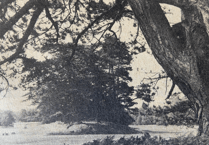FURTHER excavations on Petersfield Heath have revealed important evidence of how the area’s Early Bronze Age residents dealt with death.
Three of the 21 known monuments in this important ancient cemetery on the edge of the town were
subjected to rigorous examination.
One is Barrow 13 on Music Hill, where a town band regularly played in the late 19th century. The mound’s unusual shape suggested that it had either been the subject of antiquarian barrow-digging attentions, or received additional contributions from landscaping during the long golfing era on the Heath. In addition to learning about the structure of the mound and recovering palaeo-environmental remains, archaeologists hoped to clarify the extent of past disturbance. It proved to be substantial; an unrecorded excavation had dug a deep hole in the centre with at least three arms extending to west, north and east. The hole was dug well into the subsoil beneath the barrow. Given this background, it was with some surprise that an intact grave was discovered.
The grave contained at least 15 artefacts of flint and stone alongside a confined spread of cremated bone fragments. Two further objects were represented by hardened sand, almost certainly caused by the mineral-replacement of originally organic items, a well-known phenomenon in acidic sand environments. Skilful excavation allowed the forms of the objects to be documented and the larger one is of particular significance because the cremated remains clearly ‘issued’ from its broader end.
The object is 38.5cm long and tapers to a narrower, hand-sized rod terminated by an asymmetric knob. This handle-like character and physical contiguity to the clearly demarcated deposit of cremated bones suggests that a bag, perhaps of leather, had contained the bones and had been attached to a long wooden handle.
This is not the first time that it has been possible to deduce that an Early Bronze Age cremation was deposited in an organic bag that has since decayed.
However, hitherto there has been no evidence for such bags having been furnished with what appears on the Petersfield Heath evidence to be a rather elaborate wooden ‘handle’ which seems to go beyond something strictly functional.
It suggests a degree of ceremony was involved in the carriage of the individual’s remains to the burial site and may imply that the act of cremation took place elsewhere or at an earlier time. The concentration of barrows on Petersfield Heath is noteworthy and this new evidence may give further support to the idea that the site was regarded as an especially sacred place which was highly favoured by the elite of a wider region.
A neatly shaped rectangular whetstone found, at 22.5cm long, is probably the largest yet to have been found in an Early Bronze Age context. It may have had more than one function but its sides are grooved thus recalling grooved stones that have been interpreted as arrow-shaft smoothers. This makes an interesting connection with 10 of the flints in the grave, which have already been worked up to an intermediate stage on the way to becoming arrowheads.





Comments
This article has no comments yet. Be the first to leave a comment.